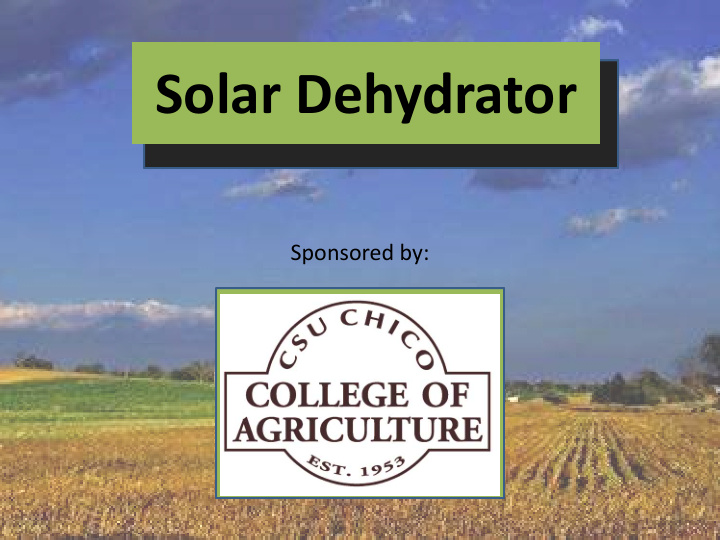



Solar Dehydrator Sponsored by:
Advisor and Sponsor Advisor and sponsor • Joseph Greene Ph.D. • Greg Kallio Ph.D. • Lee Altier Ph.D., • College of Agriculture
Team Team 1 • William Enos • Mechanical Engineering • Kris Gilmour • Mechatronic Engineering
Team Team 2 • Sou Yang • Mechanical Engineering • Cortlin St. Pierre • Mechanical Engineering
Background Background • 25% of produce wasted • Extend product shelf life • Solar convection and resistance heater • California Food Safety Standards
Design Changes Background
Design Solution Background • Hybrid Design
Design Solution Background • Moisture Resistant Strip Heater • User Interface – Simple to use
CFD Analysis Background • CFD – Fan locations
Drying Analysis Background • Fick’s Second Law of Diffusivity • Diffusivity Assumption (Fall Rate Drying Period)
Drying Analysis Background • Allowable thickness for 30°C, 0.5 m/s • 5-6 mm • Drying time for 40°C • 7.5 hours
Drying Analysis Background • Heater = 1100 [W] • Solar collector box = 1000 [W] • Target Temperature = 30°C • Target Thickness = 5-6 [mm] Heat vs Air Velocity 14000 40°C Temperature 12000 Change Required Watts 10000 30°C Temperature 8000 Change 6000 4000 20°C Temperature 2000 Change 0 0 0.2 0.4 0.6 0.8 1 1.2 Air Velocity [m/s]
Frame Fabrication Team 2
Completed Fabrication
Design Change
Finished Project
Testing Background • Quantitative Specifications Specifications Target Actual Drying Time < 12 Hours < 12 Hours Temperature Difference Spatially ±5°F ±5°F Inside Drying Chamber Volumetric Flow Rate of Air 530 CFM 400 CFM 50 lbs wet weight sliced 50 Batch Weight tomatoes a day lbs/batch
Final Budget Background $2,379.70 $178.12 $1,663.18 Engineering Cost Raw Material Purchased Parts Unused Budget $88,566.00
Sponsors Background • College of Agriculture • Student Learning Fee • Carriere Family Farm • Enos Family • Fleming Services • Hiway Truck & Trailer Parts • Willows, CA
Reflection ● Merits of the design solution ○ Efficient heat collector ○ Ample drying capacity ○ Horizontal and vertical airflow operation ● Unique problems encountered ○ Project transportation
Solutions Achieved ● Axle and hitch implementation ● Modular drying cabinet plate ● Duct
Suggestions for the Future ● Non-detachable heat collector ● Hitch location moved to the front ● Two axles ● Weight reduction ● Increased airflow ● Decreased height of the drying cabinet ● Higher output heater ● Durable coating ● Louver-oriented system for the fans
Conclusion Conclusion
Questions? Questoins
Recommend
More recommend